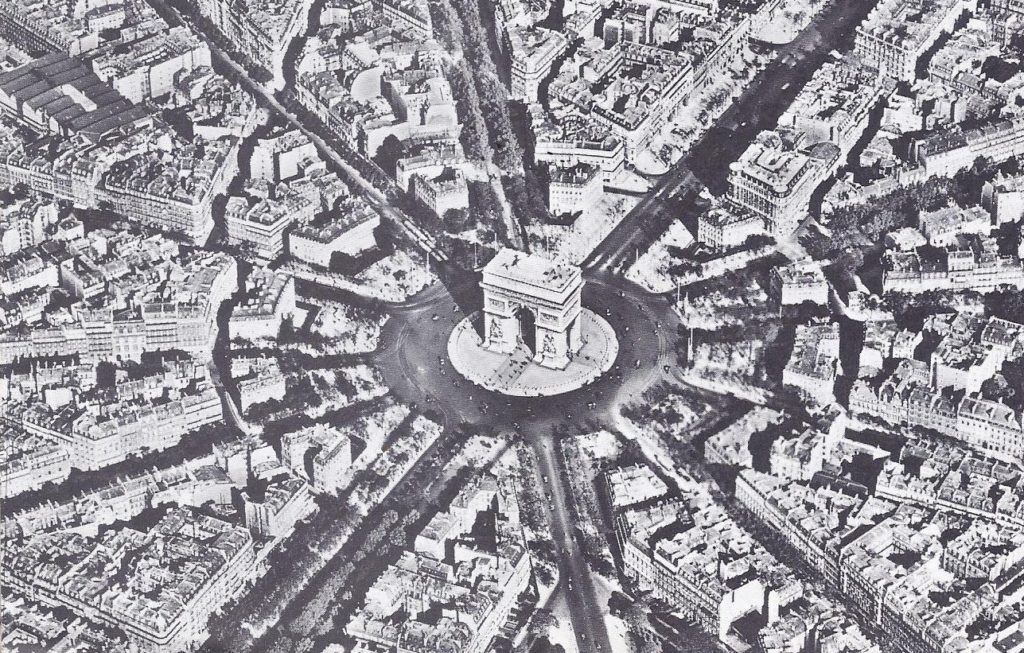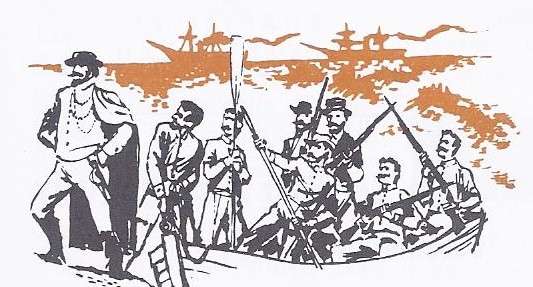On May 11, 1860 an almost incredible military campaign began with the landing of Guiseppe Garibaldi on the western tip of Sicily. Garibaldi was a handsome, dashing, reckless warrior patriot. With him were a thousand devoted followers, clad in red shirts. Maybe red shirts were easier to shoot at than green or gray, but for every bullet, they attracted a recruit from the ranks of the enemy.
The island of Sicily was one of the two parts of the Kingdom of the Two Sicilies. The other “Sicily” was the southern third of the peninsula of Italy. The capital of the Kingdom was the beautiful but overcrowded city of Naples, where a king of the Bourbon family headed one of the worst governments in Europe.
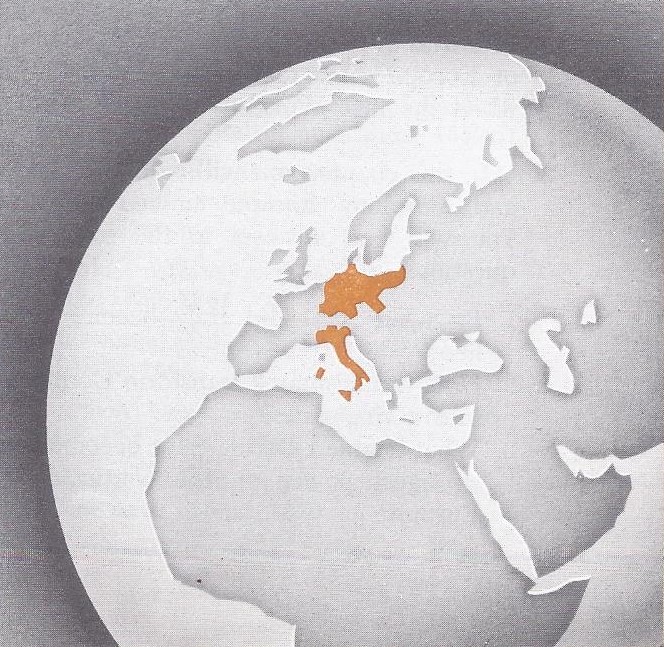
Garibaldi hated the King of the Two Sicilies for two reasons: (1) The King’s misrule was an insult to all true Italians and (2) even a good separate government at Naples would have stood in the way of bringing Italy together into a single, unified free country. Garibaldi felt that war had to be made against the King. No country already in existence would send troops on such a mission, but that didn’t bother Garibaldi. He resolved to wage his own war as a patriotic citizen of a country not yet born. He set out from Genoa, sailed westward for a few miles and then made for the Kingdom of the Two Sicilies.
The story of what followed is a story of how freedom overcomes tyranny if it has half a chance to do so. The King’s army had no heart for fighting. It melted away and as it shrank, Garibaldi’s army grew. Within a week after landing in Sicily, Garibaldi had won his first battle against the King. Two months later, Garibaldi controlled all of the island. Then he crossed over into southern Italy. On September 7, he rode triumphantly into Naples. A thousand men under a brilliant leader had driven out a worthless king and made his realm part of a new nation.
Garibaldi’s expedition was only one episode in the dramatic struggle of Italians to become a unified nation. Italy, which had been split up for centuries, achieved unification in 1870. During the same years the many separate states of Germany were being welded together into a single empire. Thus, two of the chief European countries of today took form and the map of Europe came to look much as it did when the first World War broke out in 1914.

Here we read about how Italy and Germany became unified nations. You will find answers to the following questions:
1. By what steps did Italy become unified?
2. How did Bismarck transform Germany into a single nation?
3. What enabled Germany to become the strongest power on the continent of Europe?
1. By What Steps did Italy Become Unified?
Italians had many common ties. Italians in the 1800’s possessed many of the ties which are likely to arouse national feeling in a people. With the Alps on the north and water on three sides, the Italian peninsula was marked out by nature to be a single country. The Italians spoke the same language, though with differences that sometimes. made it difficult for Italians living in the north of Italy to understand those living in the south. Italians had the same religion — that of the Roman Catholic Church.
The Italian people could look back with pride on their past. Ancient Italy had been the centre of the greatest empire of the Mediterranean world. After the Christian religion had become firmly established, Rome was the centre of the Catholic Church. During the Middle-Ages, Italian cities led western Europe in trade and wealth, Italian painters, sculptors, writers and scientists were among the most brilliant of the Renaissance.
For centuries Italy had lacked unity. Italians had not been under a single government of their own since the fall of the ancient Roman Empire. Large parts of Italy, from time to time, had been included within the Holy Roman Empire or other kingdoms or empires, but there had been no real unity. Although Napoleon I conquered the whole peninsula, he did not govern it as a single state. Except for a few details, the map of Italy in 1850 was much as it had been a hundred, or even two hundred, years before.
Italy in 1850 contained several states. In the northern part of Italy there were three rather large states. Two of them, Lombardy and Venetia, as we read earlier, were handed to Austria by the agreements at the Congress of Vienna. The other, the Kingdom of Sardinia, was independent. The name Sardinia is somewhat misleading. The Kingdom contained not only the large Mediterranean island which gave it its name, but the much more important district of Piedmont, on the mainland in the foothills of the Alps. (See the map.)
Just south of Lombardy, Venetia and the Kingdom of Sardinia were some smaller separate states — Parma, Modena and Tuscany. Across central Italy lay the Papal States, governed by the Pope. South of the Papal States was the Kingdom of the Two Sicilies. Austria, although it held only Lombardy and Venetia, exerted a great deal of influence over all the Italian states except Sardinia.
Napoleon had started the Italians on the path of national unity. Divided though Italy still was in 1850, the desire for unity had been stirring among its people for some time. The Napoleonic Wars had an important influence. On the one hand, Napoleon’s military triumphs had helped spread the principles of the French Revolution in Italy. On the other hand, like the other conquered people of Europe, the Italians in time came to resent French rule. Dislike for the French strengthened the spirit of national patriotism among the Italians. This spirit lived on and continued to grow after Napoleon’s overthrow. Neither the Congress of Vienna nor Metternich, could kill it.
Mazzini fanned the flames of Italian nationalism. One of the foremost leaders in the movement to unify Italy was Mazzini. Mazzini who was born in Genoa, was stirred into action by Austria’s continual interference in Italian affairs. He was a scholar and writer rather than a politician or statesman. Even in his days as a student, Mazzini decided to devote his life to liberating Italy. “I childishly determined to dress always in black,” he wrote later, “fancying myself in mourning for my country.” Mazzini’s longing for political freedom was matched by an equally strong desire to share that freedom with Italians everywhere. “My country,” to Mazzini, meant the whole Italian peninsula together with the islands of Sardinia and Sicily.
TIMETABLE
STEPS TOWARD A UNITED ITALY
Italian revolt failed to overthrow rulers established by Congress of Vienna, 1820 – 1821
Austrians crushed another Italian revolt. Mazzini formed Young Italy patriotic society, 1831
Mazzini set up a revolutionary republic in Rome, but was defeated, 1848
Cavour became prime minister of Sardinia and leader of Italian unification, 1852
Helped by France, Sardinia won a war with Austria and united much of northern Italy, 1859 – 1860
Garibaldi’s patriots freed Sicily and southern Italy, 1860-1861
Victor Emmanuel of Sardinia became King of Italy, 1861
Italy won Venetia after Austria was defeated by Prussia, 1866
Against the Pope’s protest, Italy took over Rome as its capital, 1870
Above all, Mazzini was an idealist who believed that the people themselves must strive for freedom and for union. “Revolution,” he said, “must be made by the people and for the people.” Mazzini’s fiery words won many supporters in the 1830’s and 1840’s. Thousands of young men joined his patriotic society, called Young Italy. They stood ready to work and even die to free all the Italian states from Austria’s control, but Mézzini met many obstacles because he was constantly stirring up revolts; he was forced to live much of his life in exile. A republic which he set up during the revolutions of 1848 lasted only a brief time. Moreover, Mazzini failed to win over many Italians who honestly desired national unity but who did not agree with his program for winning it. These middle-of- the-road patriots feared that uniting Italy under a republic would lead to the same terror and disorder which had existed during the French Revolution.
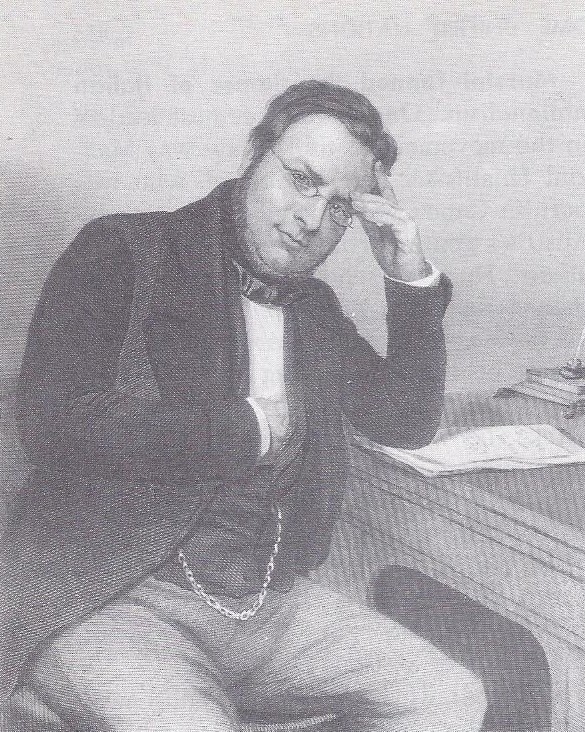
Italians turned to Sardinia for help in uniting Italy. After the uprising against Austria in 1848 failed, more and more Italian patriots became convinced that they must look to Sardinia for leadership in winning independence from Austria and in achieving national unity. The Kingdom of Sardinia had a constitution and an able and patriotic King, Victor Emmanuel II. What was more, Sardinia had for its prime minister one of the wisest statesmen in Europe, Count Cavour.
Cavour was well fitted to lead the struggle. Cavour was a stocky, bespectacled, practical-minded man. He lacked Mazzini’s ability to arouse the emotions of people by eloquent words, but he could plan for the future and work shrewdly and tirelessly to achieve his goals. Cavour had become wealthy as a scientific farmer, banker and builder of railroads. He had travelled in England and France and had seen what advantages good-sized, unified countries had over groups of small, separate states. He felt, however, that the Italian people were not yet ready to govern themselves. Also, he knew that to set up a new republic would invite interference from neighbouring monarchies. Cavour believed that the Italian states should unite not as a republic but as a limited monarchy.
If Sardinia was to take the lead in a movement for a free and united Italy, reasoned Cavour, it must itself be a strong and efficient state. He therefore set about making reforms. He built up Sardinia’s agriculture, commerce and industry. He placed Sardinia’s finances on a firm foundation. He improved education. He built railroads, canals, better roads and strengthened the Sardinian army. Italians everywhere began to look to Sardinia for leadership.
Cavour sought help outside Italy. Far-thinking Cavour realized that Sardinia, no matter how efficient, could not defeat Austria single-handed. It was necessary somehow to win an ally among the great powers of Europe. To do this Cavour must draw attention to his country. He must “put Sardinia on the map.” Cavour found the chance he was looking for in the Crimean War, 1854-1856. In this struggle Great Britain and France had come to Turkey’s aid against Russia.
Sardinia had no quarrel with Russia but went to war just the same. Sardinian soldiers fought well and won the gratitude of France and Great Britain. When the war was over, Cavour went to the peace conference at Paris. There he mingled with statesmen from Europe’s great powers and talked freely about Italy’s hope to become free and reunited. He took particular pains, at the Paris Conference and after it, to win the support of Napoleon III.
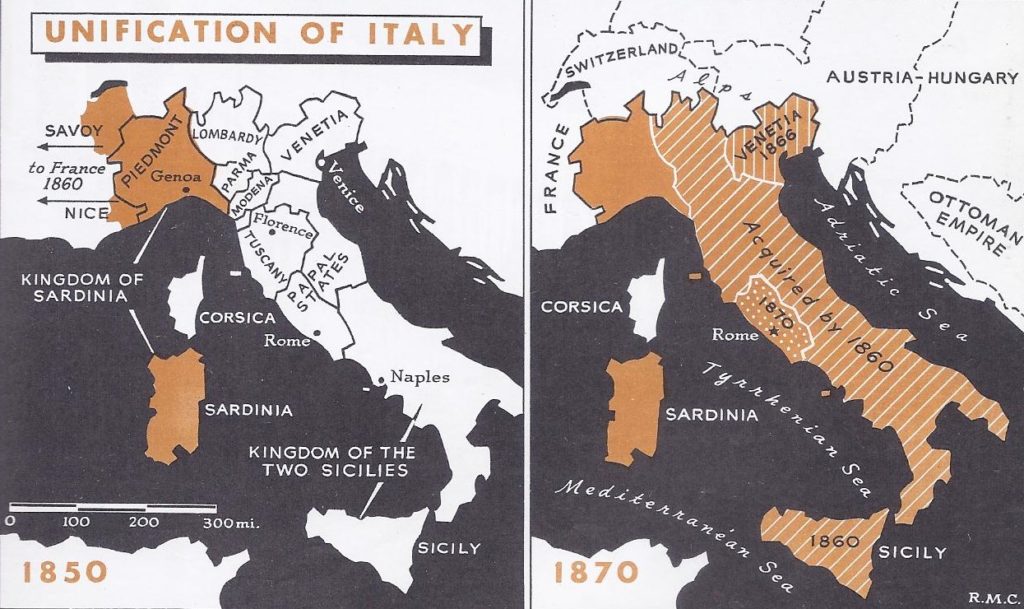
Napoleon III agreed to help the Italians. Napoleon III was a strange man. Like his famous uncle, Napoleon I, he had Italian blood in his veins, so he sympathized with the Italians in their desire to throw-off Austria’s yoke. Moreover, Napoleon was vain and longed for military glory and a chance to be a leader in European affairs. Yet he was also cautious. A successful war would strengthen his government in France, but a defeat would wreck it. In aiding Sardinia he would have to gain some profit for France.
Napoleon III finally made a secret agreement with Cavour to help Sardinia — for a price. He agreed to lead an army to drive the Austrians out of northern Italy. But in return Napoleon demanded (1) that Austria must appear to start the war and (2) that France must receive the districts of Nice and of Savoy. (See the map.) This was a hard bargain, but Cavour agreed. After all, no one except Napoleon had both the will and the power to aid Sardinia.
So far as it went, the war with Austria was successful. In 1859 Austria blundered into a trap prepared by Cavour. Austria insisted that Sardinia reduce its armed forces and declared war when Sardinia refused. This incident was all Napoleon needed to justify helping Sardinia. He marched into Lombardy with a large army and defeated the Austrians in two bloody battles. Meanwhile, revolutions swept the small independent states of Parma, Modena, Tuscany and part of the Papal States.
The French had freed Lombardy, but Austria still held Venetia. Though the job of freeing northern Italy was only half done, Napoleon III was becoming uneasy. Perhaps he was fearful that Prussia would enter the war if French victories continued. Perhaps Napoleon thought that complete unification of Italy might offend the Pope by bringing up the question of his right to rule the Papal States. At any rate, to Cavour’s astonishment and dismay, Napoleon unexpectedly made a truce with Austria.
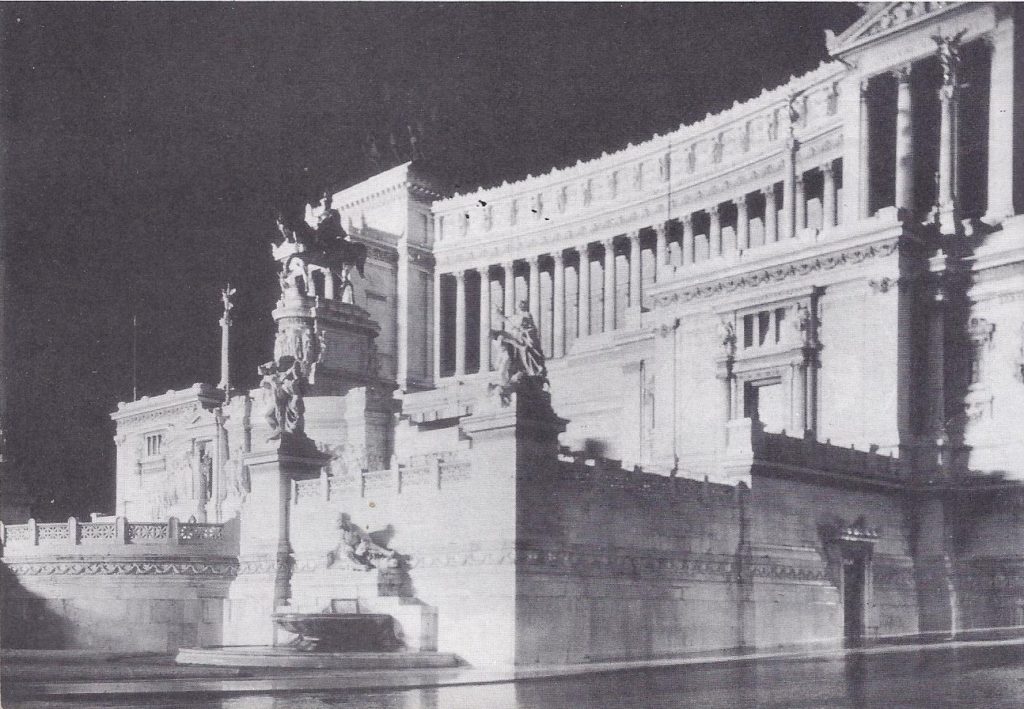
Only part of Holy was freed. Cavour wanted to continue the war without France, but King Victor Emmanuel wisely decided to stop fighting. The King felt that it was better to be satisfied with some gains rather than to risk the loss of all. Peace brought about these results: (1) Austria retained Venetia. (2) Sardinia received Lombardy. (3) Napoleon III obtained Nice and Savoy, the price he had demanded for his help. (4) By vote of the people, Parma, Modena, Tuscany and part of the Papal States were united with Sardinia. Cavour had succeeded in doubling the territory of Sardinia, but was blamed by many Italians for giving up Nice and Savoy. Among the patriots who blamed him most severely was Garibaldi.
Garibaldi planned to conquer Sicily. Along with Mazzini and Cavour, Garibaldi ranks as one of the great leaders in the movement for Italian unity. Mazzini had dreamed of unity but had not achieved it. Cavour’s shrewd deals had pushed Austria back and had joined most of northern Italy to Sardinia. Southern Italy, however, including Sicily, remained apart. Furthermore, it was harshly ruled by a tyrant king. It was just as important to free one part of Italy from the rule of an Italian tyrant as it was to free another part from the rule of a foreign power.
Garibaldi was a bold adventurer, a man of action and here was his chance to act. Unlike Cavour, Garibaldi had no use for cautious planning and alliances. In 1860, he decided to start a little war of his own against the King of the Two Sicilies.
Garibaldi’s scheme seemed a mad one. A thousand poorly armed, half-trained volunteers had challenged a kingdom having a regular army. Cavour hoped Garibaldi would succeed and many French and British statesmen secretly wished him well, but no one gave him open aid. It was as if all Europe had said to Garibaldi, “Win against odds of a hundred to one and you will be a world hero. Lose and everyone will disown you.”
Southern Italy was freed. Garibaldi had shrewdly gambled on help from the people he wished to liberate, and his gamble won. Both on the island of Sicily and on the mainland of southern Italy, large numbers of patriots rose in revolt against their hated ruler and joined Garibaldi’s “redshirts.” When the Sicilian army refused to fight, the unpopular King tied. Garibaldi marched in triumph into the capital city of Naples.
Garibaldi would have liked to turn the Kingdom of the Two Sicilies into a republic, for he favoured a democratic form of government. He even wanted to continue his conquests and march upon Rome. Cavour, however, got ahead of him by sending a Sardinian army into the Papal States. Garibaldi then gave up his own ideas for the sake of national unity. He returned to his farm on a small island after refusing all rewards and honours for the great services he had rendered his country. Meanwhile, the people of southern Italy had voted to unite with Sardinia.
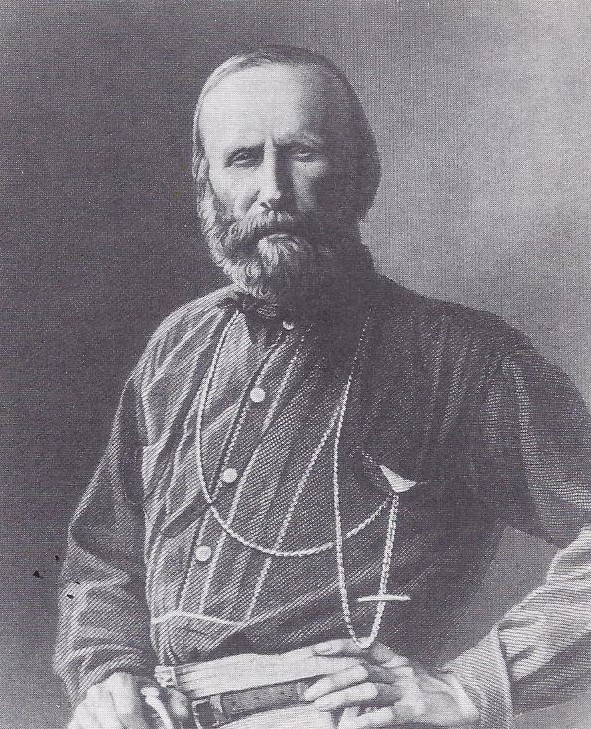
Italian unity was practically complete by 1870. In 1861 Victor Emmanuel was proclaimed ruler of the newly created Kingdom of Italy. A glance at the map will show you that this kingdom included all Italy except the territory of Venetia in the north and the western part of the Papal States around the city of Rome. These last two pieces of the Italian jigsaw puzzle were fitted into place as a result of two wars. Although these wars concerned chiefly Germany, Italy also profited from them.
By joining Prussia in a war against Austria (1866), Italy gained Venetia. Four years later, when France and Prussia were locked in war, Napoleon III withdrew French soldiers stationed in Rome. Victor Emmanuel’s troops then marched into the city. By a vote of 134,000 to 1500, the citizens of Rome voted to unite with the rest of Italy. Rome became the capital of the Kingdom of Italy. To the first Parliament which met there Victor Emmanual proclaimed, “After long trials, Italy is restored to herself and to Rome.”
Italy still had unsolved problems. Although Italy had been brought together under one government by 1870, difficult problems remained to be solved. Besides the task of building Italy into a modern nation, the government had to try to work out a satisfactory arrangement with the Pope. No longer the ruler of the Papal States or of Rome itself, the Pope withdrew to the Vatican Palace in Rome. He regarded himself as a prisoner whose land had been taken from him. Not until 1929 was the dispute between the Popes and the Italian government settled. At that time Vatican City, a small independent area within Rome itself, was created.
Finally, the Italians did not forget that there were still Italian-speaking people in the Austrian Alps and along the northem fringe of the Adriatic Sea under Austrian rule. These “unredeemed” Italians and their lands did not become part of Italy until the close of World War I.
2. How Did Bismarck Transform Germany into a Single Nation?
In its struggle for unity Germany had certain advantages over Italy. In Germany as well as Italy those who desired greater self-government and national unity had suffered severe disappointments between 1815 and 1850. German desires for unity had been ignored by the Congress of Vienna and plans for greater freedom had been checked by Metternich. Nevertheless, Germans possessed some advantages the Italians did not have.
1. Unlike Italy, the Germans had already taken two important steps toward national unity. The German Confederation, was a weak league of states, run by princes and controlled by Austria. It had no common law or citizenship, no common army or navy, no common treasury or flag, but even a weak league of states was better than no union at all. Furthermore, by 1815 the number of states in Germany had been reduced from several hundred to 38.
Germany had also made a start toward economic union. Under Prussia’s leadership, a large number of the German states had an agreement to permit goods to be shipped from one state to another without paying tariff duties. Freedom of trade among these states brought Germans closer and closer together.
2. Germany had a strong state which weaker states could join. Germany included two “powers”– Austria and Prussia. Of course, Austria would not work for German unity, because it was to its advantage to lord it over a weak and disunited Germany, but Prussia was a different matter. Unlike Austria, which ruled such non-German lands as Hungary and Bohemia, Prussia was largely German in population. It had an efficient government, though it was far from democratic. Moreover, Prussia had one of the best armies in Europe. What Germany needed was a Prussian king or statesman who had the courage to defy Austria and lead the smaller states toward national unity.
Bismarck rose to power in Prussia. Otto von Bismarck was such a statesman. He was a Prussian noble who had represented Prussia in France and in Russia. Bismarck was known as a man who believed in strong monarchy. He despised government by the people and had opposed the revolution in 1848.
Bismarck came to power by a curious twist of fate. King William I of Prussia was engaged in a bitter snuggle with the Prussian legislature. He demanded more money in order to increase the army, but the legislature refused to vote him the funds. The furious King never thought of yielding, but he did think of giving up his throne. Then he decided to take one last chance to keep his crown and get what he wanted. In 1862 he named Bismarck Prime Minister.
TIMETABLE
STEPS TOWARD A UNITED GERMANY
Congress of Vienna set up 38 independent German states, dominated by Austria, 1815
Prussia started a movement to cut down trade barriers among German states, 1819
Representatives from German states met in a national assembly at Frankfort, but failed to unify Germany, 1848 -1849
Bismarck became chief minister of Prussia, 1862
Prussia took the lead, with Austria, in a ”patriotic” German war against Denmark, 1864
Prussia defeated Austria and smaller German states in Seven Weeks’ War, 1866
Prussia organized North German Confederation of states without Austria, 1867
Prussia, with South German states as allies, won the Franco-Prussian War, 1870 – 1871
King of Prussia proclaimed German Emperor, 1871
Knowing Bismarck’s ideas, people felt there would be a fight to the finish between the King and the legislature. They were quite right. When the legislature refused to vote the taxes Bismarck requested, Bismarck sent the lawmakers home and proceeded to collect the taxes anyway. Even stout-hearted King William thought Bismarck was inviting trouble and gloomily predicted, “The people will cut off our heads.” Bismarck merely asked the King whether he wanted to die with dignity as had Charles I of England, or like Louis XVI of France whose people guillotined him after he had yielded to their demands for privileges.
Bismarck’s attitude aroused distrust. Bismarck’s blunt words and highhanded actions frightened European statesmen and enraged freedom-loving people everywhere. One of his famous sayings was, “Germany does not look to Prussia’s liberalism, but to her power. . . . The great questions of the time will be decided, not by speeches and majority resolutions that was the mistake of 1848 and 1849 but by blood and iron!” He showed how he felt about popular rights when a rebellion broke out in Poland in 1863. Bismarck, who wanted to build up a useful friendship with Russia, offered to help the Czar put down the revolt.
Bismarck had a plan for uniting Germany. Even though Bismarck was a stiff necked nobleman with little use for liberal ideas, he was not trying to be another Metternich. Unlike Metternich, Bismarck did not intend to keep things as they were. He did, however, have definite ideas about what he wanted and how to reach his goals.
Bismarck had a good reason for building up a large Prussian army — to give Prussia a commanding position in Germany. Once strong enough, Prussia could shove Austria aside by force if necessary. Bismarck had no intention, however, of allowing Prussia to become just one part of a greater Germany. Instead, he wanted Prussia to take the lead in a German union and though he disliked constitutions and rule by the people, he was willing even to put up with a parliament and give votes to all Gennans if this were the best way to place Prussia at the head of a single German nation.
Bismarck showed great shrewdness. Perhaps Bismarck’s strongest quality was his common sense. In general he saw things as they were, not as he wished them to be. Bismarck, for example, saw clearly the difficulties standing in the way of bringing the states of Germany together under one government. There would be trouble with the separate German states that had gone their own way so long. There would be trouble with other powers which did not want a strong Germany under Prussia’s leadership. But Bismarck also knew that Austria was not so strong that Prussians need tremble when Austrian statesmen frowned. He knew that Napoleon III was sometimes rash, sometimes timid and he knew that although the British might not like his policies, they would probably not fight to help Austria or France in case Prussia went to war with either of them.
Bismarck’s first war was with Denmark. Bismarck used wars and diplomatic deals to gain his end even more than had Cavour. If you glance at the Timetable of German unification, you will see that the first step was war with Denmark in 1864. The king of Denmark had tried to increase his control over two small states, Schleswig and Holstein. Holstein was in the German Confederation and both states contained many Germans. Bismarck was sure, therefore, that this quarrel with Denmark would arouse all Germans. So he got Austria to join in a war against Denmark.
Against such a combination, Denmark had no chance unless it received outside help, but Russia, as Bismarck planned, was friendly to Prussia; and neither France nor Great Britain wanted to risk an all-out European war just to protect Denmark. Denmark lost the unequal struggle.
Bismarck turned on Austria. After defeating Denmark, Bismarck deliberately picked a quarrel with Austria over what should be done with the land obtained from Denmark. The quarrel resulted in the Seven Weeks’ War of 1866. Most of the smaller German states sided with Austria, because their rulers did not want the kind of close union which Prussia would probably establish if victorious. England, France and Russia remained neutral, but Italy, sided with Prussia in order to gain Venetia.
The strengthening of the army which King William and Bismarck had worked for paid off. The Prussian army was at this time probably the best in the world. The troops were well trained and armed with new weapons. In only a single battle Austria’s power was broken. Few wars had ever been decided so quickly and few had such important results.
Prussia took Austria’s place as leader of the German states. In the peace settlement Bismarck made sure that Prussia became the strongest of the German states and the recognized leader of Germany. He wisely refused to take any land from Austria, for he knew that to do so might make that country a permanent enemy. Bismarck added to Prussia the land which had been won from Denmark, thereby gaining good seaports on the Baltic and North Seas. He also demanded that certain North German states become part of Prussia. The map shows how these additions joined the two parts of Prussia that formerly were separated. Finally, Bismarck won the right for Prussia to set up a North German Confederation. These moves clearly gave Prussia the upper hand in German affairs.
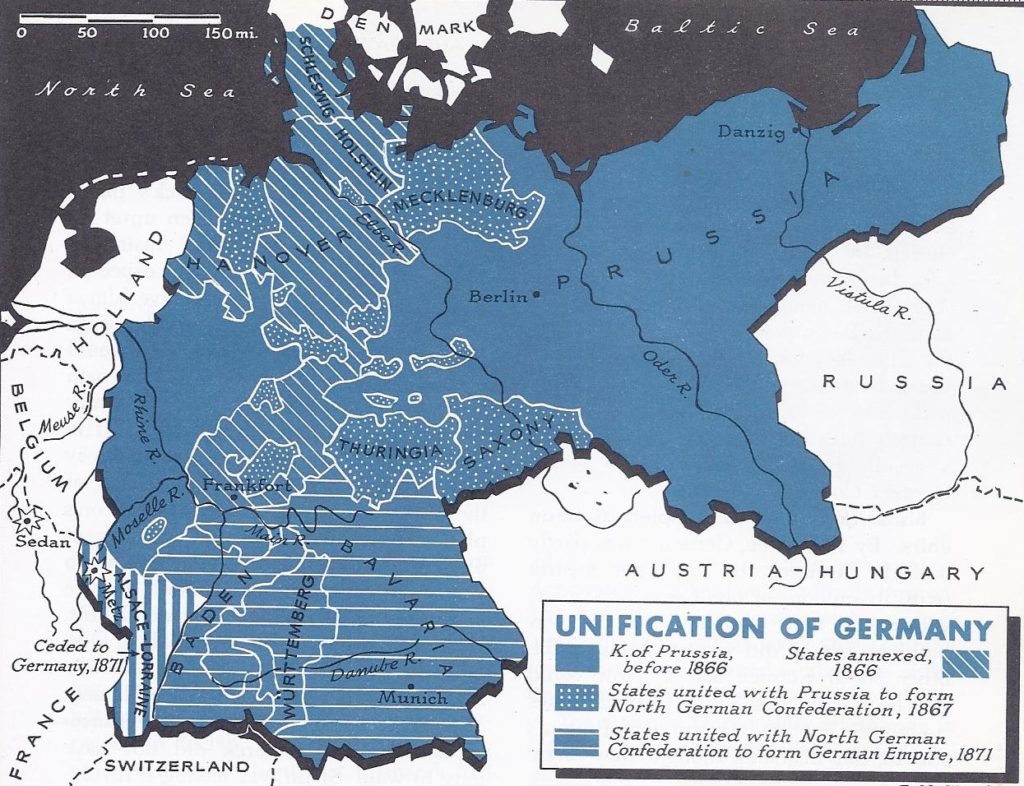
A new German nation began. Only the German states north of the Main River were members of the new North German Confederation. Austria and the other South German states had no part in it. This North German Confederation, though smaller than the old weak German Confederation of 1815-1866, was much more like a real nation. There was to be a legislature of two houses. The lower house was to be made up of members chosen by universal manhood suffrage (all the adult males having the right to vote). The members of the upper house were to be appointed by the rulers of the different states. As President of the Confederation, the Prussian King had wide powers. Furthermore, Prussia had enough votes to control both houses. As a result, Prussia controlled the North German Confederation.
Bismarck plotted to complete German unity. By 1867, then, Germany was partly unified. Bismarck did not want Austria (with its millions of non-German peoples) within the new Germany that he was building, but he did want to bring in the other South German states. How could this be done? The South German states preferred not to be under Prussia’s thumb, but Bismarck thought they might change their minds if a foreign power like France should threaten Germany. So Bismarck began plotting war with France.
It happened that Napoleon III was in a mood which suited Bismarck’s plans. The French Emperor had been upset by Prussia’s speedy Victory over Austria in the Seven Weeks’ War. He had expected a long struggle which would give him a chance to step in when both sides were exhausted and act as umpire. He would then have been able to settle German affairs and perhaps gain some territory for France, just as he had intervened in Italian affairs and won Nice and Savoy, but the sudden ending of the Seven Weeks’ War upset Napoleon’s plans. He resolved not to be caught napping again. If Bismarck made a move to annex the South German states, France might fight. Bismarck understood this, so he waited for Napoleon to make a false move. Then he could lead Prussia into a war for which France could be blamed.
Napoleon’s blunders led to the Franco-Prussian War. Bismarck did not have long to wait. Spain was having a revolution and a change in government. The vacant Spanish throne was offered to Prince Leopold, a member of the Hohenzollern family to which the King of Prussia also belonged. Napoleon was alarmed at the thought that France might be sandwiched in between two unfriendly Hohenzollern kingdoms, Prussia and Spain. He demanded that Leopold reject the offer of the Spanish throne. To Bismarck’s disgust Leopold did not accept the throne and Napoleon III appeared to have got the better of Bismarck.
Then Napoleon turned victory into defeat by demanding too much. Egged-on by his advisers, he insisted that King William of Prussia personally guarantee that never again would a member of the Hohenzollern family seek to rule in Spain. King William felt insulted and sent a long telegram to Bismarck, describing the whole affair. This was the famous Ems telegram, the first telegraph message in history to touch off a war. Bismarck shortened the telegram to make it sound as if the dispute could not be settled. Then he gave it to newspapers to publish. Feeling ran high in both countries and the hotheads at the French court urged Napoleon to declare war, which he foolishly did. So it came about that Bismarck had the war he wanted, yet France got the blame for starting it.
The Franco-Prussian War of 1870 was one-sided. The story of the Franco-Prussian War (the war between France and Prussia) can be summed up in one sentence: Prussia was ready, France was not. Napoleon had hoped to get help from Austria and the other South German states. Austria, however, stayed neutral and the other South German states (as Bismarck had shrewdly figured) took the side of Prussia. Besides having the support of these allies, the Prussian army was ready at a moment’s notice to attack the enemy.
Within a few weeks Napoleon himself was a prisoner. The great French armies had been shut up in the fortresses of Sedan and Metz (see the map) and forced to surrender. The city of Paris itself was besieged. The people of Paris formed a republican government for France and held out heroically through the first months of a cold Winter. Then, early in 1871, when food and coal ran out, Paris surrendered — and the fighting was over.
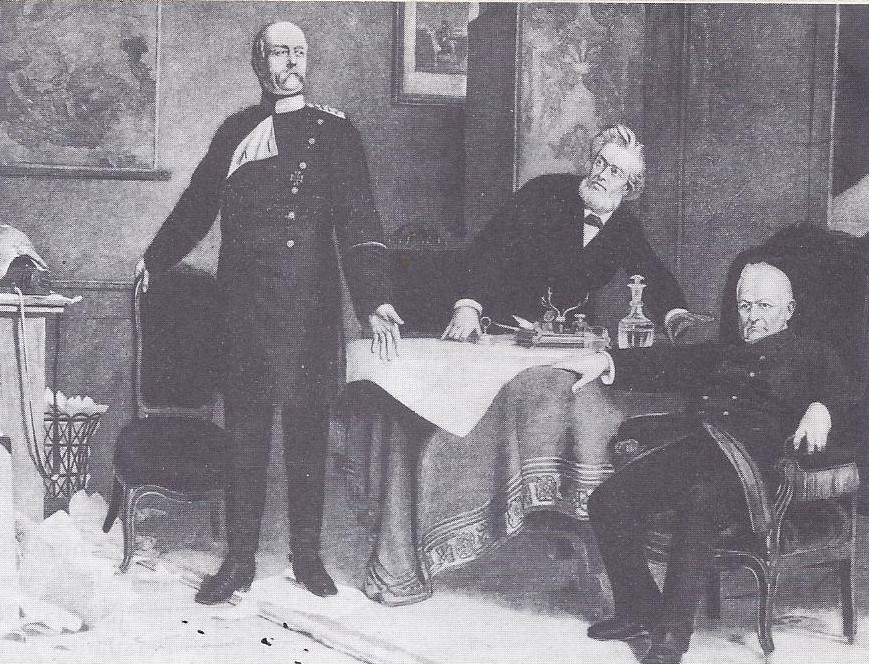
The German Empire was proclaimed in 1871. Even before the war ended, the formation of the German Empire was announced in the great palace that Louis XIV of France had built at Versailles. This new Empire differed from the North German Confederation of 1867 in two ways: (1) It included all the South German states except Austria. (2) The King of Prussia had a new title. He was no longer a mere President of the North German Confederation; he had the more dignified title of Kaiser or Emperor. (The word Kaiser, like Czar, comes from the Latin word Caesar.)
Germany set the peace terms. France had been completely beaten and had to agree to the conditions Germany demanded. France was required to pay Germany about one billion dollars, a huge sum in those days. France also had to give up the greater part of two provinces, Alsace and Lorraine (see map). Most of the people in Alsace were German speaking, while those in Lorraine spoke mostly French. In spite of these language differences, the people of both provinces preferred to remain under French rule. This fact did not worry Bismarck, who believed that statesmen should be guided by the needs of governments rather than the wishes of the people. As a result, he did not allow the people of Alsace and Lorraine to vote on the question, as had been done when Sardinia acquired territories in Italy. Actually, Bismarck himself questioned the wisdom of annexing French speaking Lorraine, but he listened to high army officials who persuaded him that Germany needed the strong fortress of Metz to defend its western boundary.
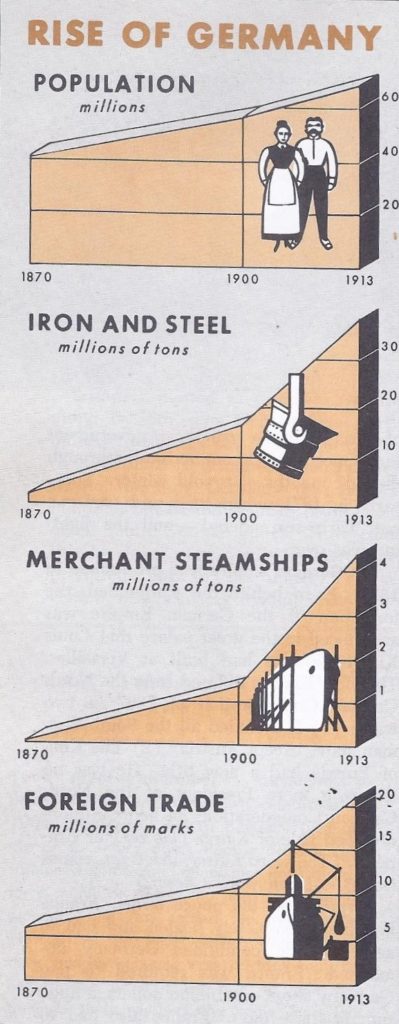
Other countries profited by the struggle between France and Prussia. When the Franco-Prussian war broke out, some neutral nations saw a chance to make gains for themselves without interference from France. The Italians, seized Rome after French forces protecting the Pope were withdrawn. Russia began to build a fleet on the Black Sea. With French troops busy fighting the Germans, there was no nation to check Russia’s action except Britain and the British did not wish to act alone.
Even distant Mexico was affected by the rivalry between France and Prussia. In 1863 Napoleon III had sent French troops into Mexico. He wanted to extend France’s colonial empire in the New World in order to build up France’s foreign trade. Due to Napoleon’s influence, an Austrian archduke, Maximilian, was proclaimed Emperor of Mexico. Such actions on the part of the French violated the Monroe Doctrine, but the United States could take no action because the American War between the States was going on at that time. Four years later in 1867, however, Napoleon recalled his troops from Mexico. He was beginning to realize he would need all his soldiers at home. Besides, the War between the States was over and the United States was threatening to use force to uphold the Monroe Doctrine. With the French troops gone, the Mexicans captured Maximilian and executed him.
3. What Enabled Germany to Become the Strongest Power on the Continent of Europe?
The unification of Italy was of interest chiefly to the Italians themselves. A united Italy did not seem to threaten or endanger any other country. The unification of Germany changed the balance of power in Europe, indeed in the whole world. During the 1500’s Spain had been the most powerful European nation, whose every move the statesmen of other countries had to watch. From the time of Richelieu in the 1600’s, down to 1870, France had been the chief power on the mainland of Europe. Nations lined up as friends or enemies of the French. From 1870 to 1945 (that is, from the Franco-Prussian War to the end of World War II) Germany was the power that other nations had to watch. Why was this so? The answer is twofold. (1) Once unified, Germany entered upon a period of remarkable industrial growth. (2) There were no other powers on the continent strong enough to challenge Germany’s military might.
Industry made Germany strong. Germany’s strength depended as much upon developing its natural resources as on Bismarck’s policy of “blood and iron,” or military power. Germany had plenty of coal, iron and German scientists made great progress in applying science to industry. As a result, Germany made rapid strides in the steel and chemical industries. Germany also became the world leader in producing goods requiring exact workmanship, such as telescopes, camera lenses and other kinds of optical glass.
After becoming unified, Germany entered upon a period of prosperity and growth such as it had never experienced before. Before the close of the 1800’s, the Germans even began to rival the British in coal, iron and steel production and in shipbuilding. The population rose from 40 million in 1871 to nearly 70 million during World War 1. Among European countries only Russia had more people or a larger army, but Russia did not compare with Germany in wealth and industry. By about 1890 migration from Germany to the United States, which brought millions of valuable citizens, had almost ceased. Employment at good wages could now be had without leaving Germany.
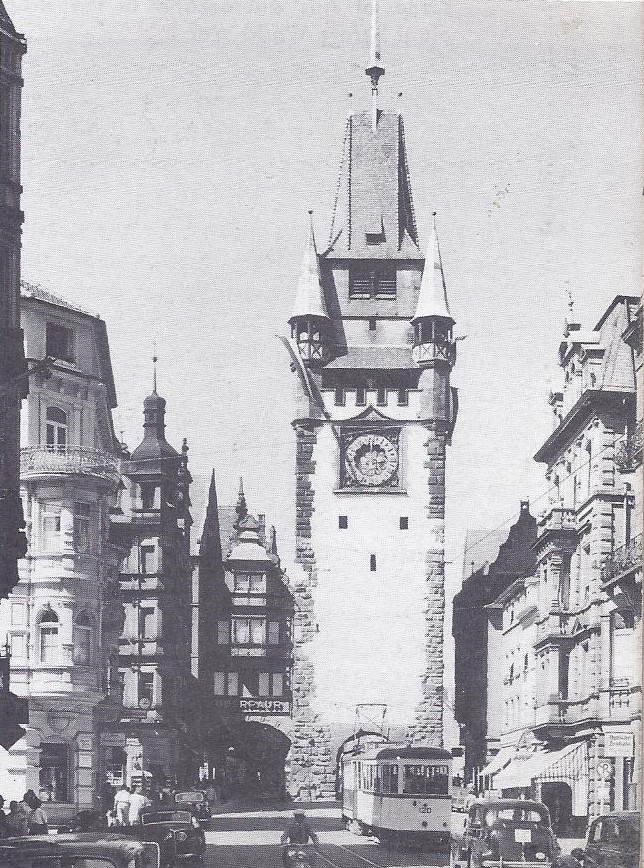
Bismarck continued his able leadership. Cavour had died while uniting Italy, but Bismarck held his high office for 20 years after he had unified Germany. Bismarck used these years from 1871 to 1890 to strengthen Germany even more. His chief interest was in building up Germany’s power in foreign affairs, but he also took steps to strengthen Germany at home. Railroads were built and joined together in one system. Imported goods were taxed heavily in order to “protect” German made goods of the same kind. The government aided shipping companies and acquired colonies to serve as markets for German goods. Workingmen were helped too. Bismarck established a system of old age pensions and government insurance which other countries imitated. Here he was more interested in building a strong and prosperous Germany than in looking after the welfare of German workers.
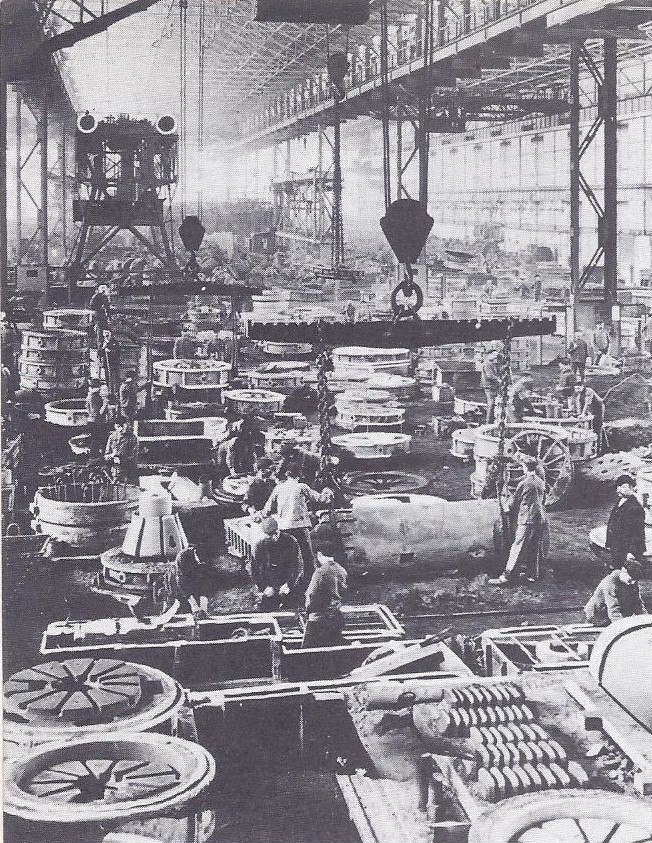
Germany’s government was well organized but undemocratic. Germany’s growth was further aided by efficient government. This government, however, was undemocratic, for the common people had little voice in it. Germany had a twohouse legislature. Members of the lower house, or Reichstag, were elected by German men over 25 years of age, but the Reichstag had little power. It could not, for example, control the Chancellor or Prime Minister, who represented the Kaiser and who held office whether the Reichstag liked him or not. Moreover, the members of the upper house were chosen by the rulers of the different states in Germany. This upper house had much more power than the Reichstag.
The state governments of Germany were even less democratic than the government of the German Empire. Prussia and most of the other German states gave more voting power to wealthy men than to ordinary citizens. In short, in Germany the upper classes actually held the power.
Moreover, Germany was controlled by Prussia. The Prussian King was German Emperor and Prussia had enough votes in the legislature to block any changes in the constitution or the army. Bismarck, the “practical” man, had brought about German unity, but unity was won at the expense of democracy. Even so, because Germany was strong, united and prosperous, the majority of the German people were not dissatisfied.
German military men had great power. The army had great power in Germany. In democratic countries like the United States or Great Britain, the army is controlled by the civilian President or Prime Minister, together with the members of Congress or Parliament who are responsible to the people. The German army depended directly and personally on the German Kaiser, who was not an elected ruler. The officers in control of the army did not take orders from the Chancellor or even from the Reichstag.
Bismarck, sometimes referred to as the “Iron Chancellor,” was strong enough to direct Germany’s policies as he thought best, but under later and weaker Chancellors, the army chiefs began to have more say about how Germany should deal with other countries. This is one reason why Germany was called a “militaristic” nation.
Austria was reorganized as Austria-Hungary. Germans made great strides after 1871, but Germany’s power was also dependent on the fact that Germany had no powerful rivals. Austria, whose statesmen had influenced Europe for so many years after 1815, had lost standing as a result of its quick defeat in the Seven Weeks’ War. Austria now had to “put its house in order.”
In 1867 Austria adopted a constitution, which was only a half measure for a country containing so many national groups. Under this constitution, the old Austrian Empire became Austria-Hungary. Austria and Hungary were separate states with their own legislatures and with their own ministries responsible to those legislatures. They were, however, bound together by a common ruler, Francis Joseph of the Hapshurg family. Francis Joseph was both Emperor of Austria and King of Hungary. The two countries also had common ministries for war and foreign affairs.
The new arrangement, which favoured Germans and Hungarians, failed to satisfy the other national groups in Austria-Hungary. The Czechs, or Bohemian Slavs, wanted self government. Other groups within Austria-Hungary — Slovaks, Croats, Poles, Serbs, Italians and Romanians — grumbled too. The currents of national feeling were running strong and Austria-Hungary seethed with unrest.
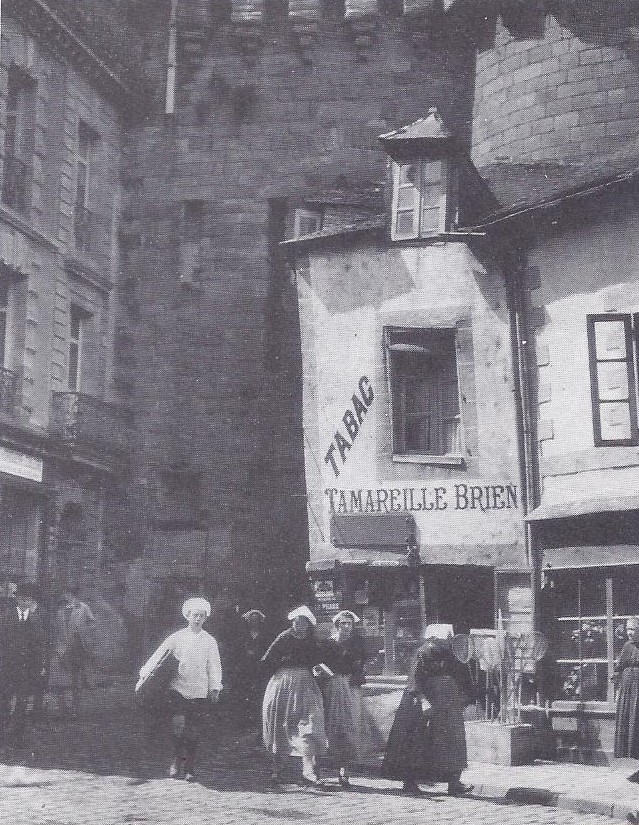
France went through a period of discouragement and uncertainty. The Franco-Prussian War left France a discouraged and weakened country. To have been beaten so easily was humiliating; Frenchmen were sharply divided as to what kind of government they wanted. They had set up the Third Republic in 1870, but for several years there was a see-saw struggle between those who favoured a monarchy and those who preferred a republic. There was a terrible uprising in Paris. Thiers, the statesman who was head of the government, managed to crush the rebellion and keep France on a middle path.
In 1875, France adopted a new constitution with a President and a two-house legislature. Unlike our President, the President of the Third Republic was little more than a figurehead. The real power in France rested with the cabinet officers or ministers, who remained in office only so long as they were backed up by a majority of the votes in the legislature.
For a number of years conditions in France remained unsettled. Frenchmen were split into so many political parties that no party could hold a majority in the legislature for any length of time. The fact that one set of party leaders followed another in short order was a handicap to France’s stability. For a dozen years, too, France was badly split by the so-called Dreyfus case. Dreyfus was a Jewish army captain who was tried and convicted of treason. The case created great excitement, for half of France believed him to be an innocent man who had been railroaded to prison. People who favoured a French monarchy instead of the Republic tended to join the group which claimed Dreyfus was guilty. Dreyfus was finally cleared in 1906, but the case had seriously upset the nation. Nevertheless, before 1914 the Third Republic had become firmly established. France had regained much of its prosperity and had become one of Europe’s chief democracies.
Under Bismarck, unified Germany had become the strongest power on the continent. France had lost the leadership it had held for two centuries and Austria no longer was in a position to bully Italy or the German states. Sprawling Russia was big but not powerful; its industries were few and not well developed. Great Britain was busy with its vast colonial empire. So long as Bismarck ran the German Empire, Germany’s policies did not seriously conflict with those of Great Britain.
In time, however, Germany’s leadership became more reckless. Not only France but other nations eyed Germany’s growing power watchfully. When Germany made an alliance with Italy, Austria and particularly when Germany built a great navy, the other great powers — France, Russia and Great Britain drew closer together. Germany’s bid for world leadership, therefore, opened up a new power struggle.
